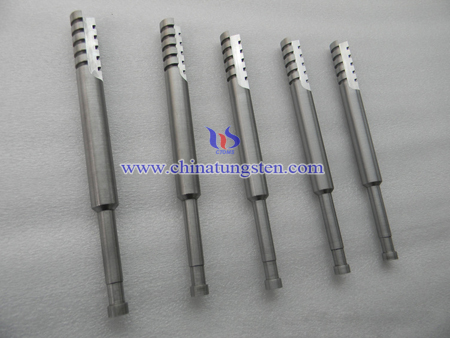Tungsten Powder and Sputter Targets
- Details
- Category: Tungsten Information
- Published on Monday, 27 June 2016 18:06
A method is provided for fabricating tungsten sputter targets having a density of at least about 97% of theoretical density and an oxygen content of at least about 100 ppm less than the starting powder. According to the principles of the present invention, a tungsten powder having a powder size less than about 50 μm and an oxygen content less than about 500 ppm is hot-isostatic pressed at a temperature of about 1200° C. to about 1600° C. and a pressure of at least about 15 ksi for at least about 3 hours. A high-purity sputter target is further achieved by using a tungsten starting powder having a purity higher than about 99.999%.
In the manufacture of sputter targets used in the semi-conductor industry, and more particularly to sputter targets used in physical vapor deposition (PVD) of thin films onto complex integrated circuits, it is desirable to produce a sputter target that will provide film uniformity, minimal particle generation during sputtering, and desired electrical properties. Furthermore, to meet the reliability requirements for diffusion barriers or plugs of complex integrated circuits, the sputter target must have high-purity and high-density.
Current methods to achieve suitable sputter targets for use in complex integrated circuits involve either hot-pressing or cold-isostatic-pressing followed by high temperature sintering. Using either of these techniques, the density of the pressed target material is about 90% of theoretical density. To obtain that 90% density, the sintering process needs to proceed at a minimum of 1800° C. This high temperature results in a significant growth of the grains. Large grain size in sputter targets is deleterious to the uniformity of the deposited films. Furthermore, the sputter targets fabricated by these methods have a high oxygen content, which results in a high film electric resistivity. In addition, these processes typically involve pressing in a graphite die mold. Some volatile contaminations are contributed to the targets by this graphite mold, which results in an increase in the impurities in the films and deteriorates the reliability of the sputter devices. For example, graphite has a high alkaline element which evaporates out of the mold and is absorbed by the sputter target during pressing and sintering. Thus, the sputter targets fabricated by the hot-press or cold-isostatic-press followed by high temperature sintering have proved unreliable for use in complex integrated circuits.
There is thus a need to develop a method for fabricating high-purity, high-density tungsten sputtering targets that will meet the reliability requirements for complex integrated circuits.
The present invention provides a tungsten sputter target having a density of at least about 97% of theoretical density and an oxygen content of at least about 100 ppm less than the starting powder. Furthermore, this high-density, low oxygen sputter target may be produced with a metallic purity of at least about 99.9995. This high-density, high-purity tungsten sputter target is fabricated by (a) providing a tungsten powder having a purity higher than about 99.999%, a powder size smaller than about 50 μm and preferably smaller than about 20 μm, and an oxygen content less than about 500 ppm; and (b) hot-isostatic-pressing the powder at a temperature between about 1200° C. to about 1600° C. at a pressure of at least about 15 ksi for at least about 3 hours. In a preferred embodiment of the invention, the tungsten powder has a purity of at least 99.9995%, a powder size of less than about 10 μm, and an oxygen content less than about 300 ppm.
In a further preferred embodiment of the present invention, hot-isostatic-pressing is performed at a temperature of about 1400° C. and a pressure of about 40 ksi for about 7 hours. Where a desired target diameter to height ratio is greater than about 3, the method of fabricating the sputter target preferably includes the additional step of cold-isostatic pressing the powder prior to hot-isostatic-pressing.
In a preferred embodiment of the invention, the powder is pressed in a powder capsule made of either titanium, iron, or an alloy thereof, to reduce the oxygen level of the tungsten.
According to the principles of the present invention, a tungsten sputter target is fabricated having an oxygen content of at least about 100 ppm less than the starting powder and a density higher than 97% of theoretical density. By starting with a high purity powder, such as 99.999% purity or higher tungsten powder, a high-purity sputter target may also be achieved. This high-purity, high-density tungsten sputter target can be used in the physical vapor deposition of thin films as diffusion barriers or plugs in complex integrated circuits.

| Tungsten Powder Supplier: Chinatungsten Online tungsten-powder.com | Tel.: 86 592 5129696; Fax: 86 592 5129797;Email:sales@chinatungsten.com |
| Tungsten News & Prices, 3G Version: http://3g.chinatungsten.com | Molybdenum News & Molybdenum Price: http://news.molybdenum.com.cn |



 sales@chinatungsten.com
sales@chinatungsten.com